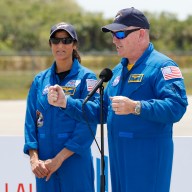 A recent work by Ellen Crenshaw.
A recent work by Ellen Crenshaw.
It’s easy — and not altogether incorrect — to assume that Boston Comic Con is all about nerds hawking their sci-fi/fantasy stories told through sequential pictures, that they’ve crafted in hopes of one day being licenced for a multimillion dollar summer blockbuster or TV show with lots of explosions. But, in actuality, numerous tables at the con will be occupied by artists with much, much quirkier agendas.
Consider Fanartica,a Tumblr-based illustration collective, founded by Boston couple Ellen Crenshaw and Matt Boehm, who will be presenting a sort of “best-of” Fanartica book in Artist Alley.
For approximately two years, Fanartica’s membership of more than 20 illustrators, designers and animators have been creating fan art — art designed to appeal to fans of a particular subject. Their series of ‘90s Nickelodeon-themed pieces was avidly reblogged. Later, the group was assigned to mashup the works of Wes Anderson and Studio Ghibli. Crenshaw met the task with a portrait titled “Fantastic Royal Princess Mononokebaum.” Most recently the Fanartica tumblr was littered with famous pop culture figures exposing their posteriors.
We spoke with Crenshaw a bit about Fanartica, as well as how her creative style and sensibilities — which, outside of Fanartica, are much more reality based — click with the Comic Con masses.
Your personal work has this whole bohemian “Family Circus” thing happening. How does that go over at Comic Con, where people are mostly preoccupied with things like superheroes and zombies and so forth?
I have mini-comics that I’ve made and a couple of anthologies, and I’ll be bringing those with me. But mostly, I’m there representing Fanartica. I feel it has a good home at Boston Comic Con. But at Artist Alley, there are all sorts of different types of comics. That was refreshing to see, and kind of put my previous idea of Comic Con on its head when I went last year.
What surprised you the most about last year’s Comic Con?
I didn’t get the chance to go around the whole Con. But I definitely expected Artist Alley to be mostly artists who … even though they’re independent people … I still expected them to have a more mainstream idea of what a comic is supposed to be. But I was pleasantly surprised to see the kinds of comics that I’m into — real life stories that relate to me and draw me in. I even saw folks selling greeting cards that told a story, and different paper bits that weren’t comics at all. I thought that was interesting. [Artist Alley] had a presence that the alternative comic cons have, where it’s not all comics at all, but crafts that appeal to a comics audience.
Why draw real people in plausible situations instead of imaginary people in fantastic situations?
It probably boils down to the fact that it’s not where my brain goes. If I’m sort of telling myself, “Write what you know,” I’ll end up either writing about myself, or historic things that happened in real life that I can research, or things that are heavily influenced by my own experience, although that wasn’t always the case. In high school, when I was really, really getting into comics, I was reading X-Men, Spider-Man and things like that. It wasn’t until I got my hands on “Blankets” by Craig Thompson that the switch got totally flipped. It got me into a new genre of comics I could better relate to. And I like the self-contained stories, too. I don’t have the patience to follow a 500-issue story.
















